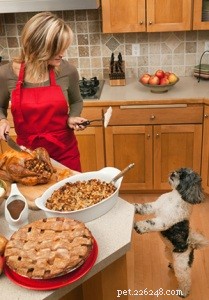Door Sarah-Anne Reed, holistische hondentrainer en eigenaar van Pack Dynamics, LLC ®
Soms moedigen we onze hond aan om te bedelen zonder het te beseffen. Dit is hoe:
• Geef je ze eten van je bord nadat je klaar bent met eten?
• Laat je ze je kom schoonlikken nadat je een ijsje hebt gegeten?
• Geef je ze wat van je eten als ben je bezig met het bereiden van maaltijden in de keuken?
• Sluipt je kind eten naar ze toe terwijl ze aan het eten zijn?
• Valt er soms eten uit de kinderstoel op de grond?
• Denk je dat het is schattig als je hond alles opzuigt dat op de grond valt?
Dit zijn veelvoorkomende fouten die mensen maken en die bijdragen aan het bedelen van hun hond terwijl ze eten of aan de eettafel hangen als ze gasten hebben.

4. Consistency is key: After a while, your dog will realize that their old tactics of trying to get food don’t work, and they will stop begging. The key is to be patient and consistent. They may add to their repertoire of trying to tell you that they want some of your food. Don’t worry, this means that your dog is smart and getting creative to get your attention. Just stay strong and don’t give in. You won’t hurt their feelings; you are just letting them know that they can’t demand food from you. You would never give a child another cookie if they had a tantrum because they didn’t get their way. It’s vital that we have clear boundaries with our dogs and not give in to their demands as they beg for food.
Most dogs enjoy variety in their food, just like we do. You can add some roasted sweet potatoes or carrots to their food as a special treat. Raw broccoli is a great option too. Some dogs like sweeter treats, like bananas or blueberries.
Dogs like different textures; some dogs prefer crunchy, others would prefer something steamed or roasted. Just like us, every dog is unique. Make sure that you don’t give them anything seasoned, as it could be harmful. Here is a complete list of human foods and whether they are safe for dogs.
Sarah-Anne Reed has a unique set of skills, experience, and education that allow her to offer an innovative, dynamic approach to solving canine behavioral issues.
For over 12 years, Sarah-Anne has dedicated herself to a life-long mission of helping families develop a deeper bond with their dog using a holistic approach. She addresses each integrated dynamic of the relationship while bridging the communication gap between humans and canines. Sarah-Anne’s practice focuses on understanding and respecting dogs as a different species and honoring them as individual beings.
With a professional background in human psychology, Sarah-Anne understands that the root cause of most canine behavioral issues are related to our misunderstanding of how dogs communicate and how we relate to them. Her training is empowering, as she teaches clients how to understand their dog’s behavior and how to implement effective techniques to truly help their dog, using a respectful, kind, gadget-free, and loving approach. She can be reached through her website.
If you are interested in having a well-trained dog, you are a candidate for pet insurance. Make sure your dog is covered in case he gets into a food that is toxic to pets by setting up a pet insurance plan. Start by getting a quote.